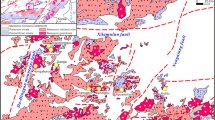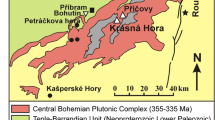Abstract
The Camagüey district, Cuba, is known for its epithermal precious metal deposits in a Cretaceous volcanic arc setting. Recently, the La Unión prospect was discovered in the southern part of the district, containing gold and minor copper mineralization interpreted as porphyry type. Mineralization is hosted in a 73.0 ± 1.5 Ma calc–alkaline I-type oxidized porphyry quartz diorite intrusive within volcanic and volcaniclastic rocks of the early Cretaceous Guáimaro Formation. The porphyry is affected by propylitic alteration and crosscut by a network of quartz and carbonate veinlets and veins. Chlorite, epidote, sericite, quartz, and pyrite are the main minerals in the early veins which are cut by late carbonate and zeolite veins. Late barite pseudomorphously replaces pyrite. Gold is associated with pyrite as disseminations in the altered quartz diorite and in the veins, occurring as inclusions or filling fractures in pyrite with 4 g/t Au in bulk samples, and up to 900 ppm Au in in pyrite. Fluid inclusion and oxygen isotope data are consistent with a H2O–NaCl–(KCl) mineralizing fluid, derived from the quartz diorite magma, and trapped at least at 425°C and 1.2 kbar. This primary fluid unmixed into two fluid phases, a hypersaline aqueous fluid and a low-salinity vapor-rich fluid. Boiling during cooling may have played an important role in metal precipitation. Pyrite δ34S values for the La Unión prospect range between 0.71‰ and 1.31‰, consistent with a homogeneous magmatic sulfur source. The fluids in equilibrium with the mineralized rocks have estimated δ18O values from 8‰ to 11.8‰, calculated for a temperature range of 480–505°C. The tectonic environment of the La Unión prospect, its high gold and low copper contents, the physical–chemical characteristics of the mineralizing fluids and the isotopic signature of the alteration minerals and fluids indicate that the La Unión gold mineralization is similar to the porphyry gold type, even though the ore-related epidote–chlorite alteration can be classified as propylitic and not the classic potassic and/or phyllic alteration. The low copper contents in the prospect could be due to a mineralizing fluid previously saturated in copper, which is indicated by trapped chalcopyrite crystals in high-temperature fluid inclusions. The low-temperature paragenesis, represented by carbonate, zeolite and barite, indicates epithermal overprint. The study shows the potential for other gold porphyry-type deposits in the Cretaceous volcanoplutonic arc of Cuba.






Similar content being viewed by others
References
Alonso J, Barroso A, Molina R, Valle C, Donet P (2001) Informe Reconocimiento Geológico para oro y otros metales en el sector Colombia-Barrueto. Província de Camagüey. Empresa Geólogo-Minera Camagüey. Material inédito. Arquivo do Instituto de Geologia e Paleontologia, Havana, p 54 (internal report)
Bodnar RJ (1993) Revised equation and table for determining the freezing point depression of H2O–NaCl solutions. Geochim Cosmochim Acta 57:683–684
Bodnar RJ (1994) Synthetic fluid inclusions: XII. The system H2O–NaCl. Experimental determination of the halite liquidus and isochores for 40 wt.% NaCl solution. Geochim Cosmochim Acta 58:1053–1063
Bush WA, Sherbakova IN (1986) New data on the deep tectonics of Cuba. Geotectonics 20(3):24–43
Clayton R, Mayeda TK (1963) The use of bromine pentafluoride in the extraction of oxygen from oxides and silicates for isotopic analysis. Geochim Cosmochim Acta 27:43–52
Clayton R, O’Neil JR, Mayeda TK (1972) Oxygen isotope exchange between quartz and water. J Geophys Res 67:3057–3067
Escobar E, Roque F, Stanek K, Balvis C, Pérez J, García A, Jiménez L, Pereira F (1988) Proyecto de búsqueda orientativa y detallada de metales básicos y nobles en la zona Vidot-Siboney. Empresa Geologo-Minera Camagüey (inédito). Fondo Geológico Nacional, Havana. p. 221
Gammons CH, Williams-Jones AE (1997) Chemical mobility of gold in the porphyry–epithermal environment. Econ Geol 92:45–59
Goldstein RH, Reynolds TJ (1994) Systematics of fluid inclusions in diagenetic minerals, SEPM Short Course 31. SEPM, Oklahoma
Hall CM, Kesler SE, Russel N, Piñero E, Sanchez R, Perez M, Moreira J, Borges M (2004) Age and tectonic setting of the Camagüey volcanic-intrusive arc, Cuba: evidence for rapid uplift of the western Greater Antilles. J Geol 112:521–542
Hedenquist JW, Lowenstern JB (1994) The role of magmas in the formation of hydrothermal ore deposits. Nature 370:519–527
Heinrich CA (2005) The physical and chemical evolution of low-salinity magmatic fluids at the porphyry to epithermal transition: a thermodynamic study. Miner Depos 39:864–889
Ianev SN, Tchounev DC, Tzankov TV (1993) El complejo volcano-sedimentario cretácico de Cuba Central (Unificación litoestratigráfica y ambiente paleogeodinámico). Doc Lab Géol Lyon 125:223–240
Iturralde-Vinent MA (1996) Introduction to Cuban Geology and Geophysics. In: Iturralde-Vinent M A (ed) Ofiolitas y arcos volcánicos de Cuba. IUGS/UNESCO International Geological Correlation Program 364: 3–35
Kesler SE, Hall CM, Russel N, Piñero E, Sanchez R, Perez M, Moreira J (2004) Age of the Camagüey gold–silver district, Cuba: tectonic evolution and preservation of epithermal mineralization in volcanic arcs. Econ Geol 99:869–886
Kyser TK (1987) Equilibrium fractionation factors for stable isotopes. In: Kyser TK (ed) Short course in stable isotope geochemistry of low temperature fluids, vol. 13. Mineralogical Association of Canada Short Course Handbook, pp. 1–84
Lavandero R (1994) Ambientes geodinámicos y su relación con los yacimientos minerales metálicos en la Isla de Cuba. In: Congreso cubano de geología y geofísica. Santiago de Cuba, Resumos
Ohmoto H, Goldhaber MB (1997) Sulfur and carbon isotopes. In: Barnes HL (ed) Geochemistry of hydrothermal ore deposits, 3rd edn. J Wiley, New York, pp 517–611
Pérez M, Sukar K (1994) Magmatismo granitoideo cretácico en Camagüey. Resúmenes del segundo Congreso Cubano de Geología, Santiago de Cuba
Roedder E (1984) Fluid inclusions. Rev Mineral 12:317–355
Roedder E (1992) Fluid inclusion evidence for immiscibility in magmatic differentiation. Geochim Cosmochim Acta 56:5–20
Roedder E, Bodnar RJ (1980) Geologic pressure determinations from fluid inclusion studies. Ann Rev Earth Planet Sci 8:263–301
Rye RO, Ohmoto H (1974) Sulfur and carbon isotopes and Ore Genesis: a review. Econ Geol 69:826–842
Santana MMU (2004) Caracterização da mineralização do tipo Au ± Cu pórfiro do setor La Unión, Provincia de Camagüey, Cuba. MSc dissertation, Universidade de Brasilia, Brasil
Shepherd TJ, Rankin AH, Alderton DHM (1985) A practical guide to fluid inclusion studies. Blackie, New York
Sillitoe R (2000) Gold-rich porphyry deposits: descriptive and genetic models and their role in exploration and discovery. Rev Econ Geol 13:315–345
Stefanini B, Williams-Jones AE (1996) Hydrothermal evolution in the Calabona Porphyry Copper System (Sardinia, Italy): the path to an uneconomic deposit. Econ Geol 91:774–791
Sterner SM, Hall DL, Bodnar RJ (1988) Synthetic fluid inclusions. V: solubility relations in the NaCl–KCl–H2O system under vapour-saturated conditions. Geochim Cosmochim Acta 52:989–1005
Zhang YG, Frantz JD (1987) Determination of the homogenization temperatures and densities of supercritical fluids in the system NaCl–KCl–CaCl2–H2O using synthetic fluid inclusions. Chem Geol 64:335–350
Zheng YF, Simon K (1991) Oxygen isotope fractionation in hematite and magnetite: a theoretical calculation and application to geothermometry of metamorphic iron formation. Eur J Mineral 3:877–886
Acknowledgments
The authors thank the Cuban government agencies Instituto de Geología y Paleontología and Empresa Geólogo-Minera Camagüey for the opportunity to carry out this study and for providing access to the area, samples, and to the existing data. Dr. Kazuo Fizikawa, from CNEN (Brazil), is acknowledged for the Raman analyses. Coordenação de Aperfeiçoamento de Pessoal de Nível Superior–CAPES (Brazil) is acknowledged for granting M. Moura fellowship support at Queen’s University. MU Santana thanks CNPq–Brazil for fellowship support during her MSc degree and Nilson F. Botelho for CNPq grant that supported some of the analytical costs. We also thank Kerry Klassen (Queen’s University) for the stable isotope analyses and Mark Badham for English editing. Constructive reviews by Timothy Baker, Steffen Hagemann, and Peter Neumayr resulted in many improvements to this contribution.
Author information
Authors and Affiliations
Corresponding author
Additional information
Editorial handling: B. Lehmann
Rights and permissions
About this article
Cite this article
Santana, M.M.U., Moura, M.A., Olivo, G.R. et al. The La Unión Au ± Cu prospect, Camagüey District, Cuba: fluid inclusion and stable isotope evidence for ore-forming processes. Miner Deposita 46, 91–104 (2011). https://doi.org/10.1007/s00126-010-0313-8
Received:
Accepted:
Published:
Issue Date:
DOI: https://doi.org/10.1007/s00126-010-0313-8




